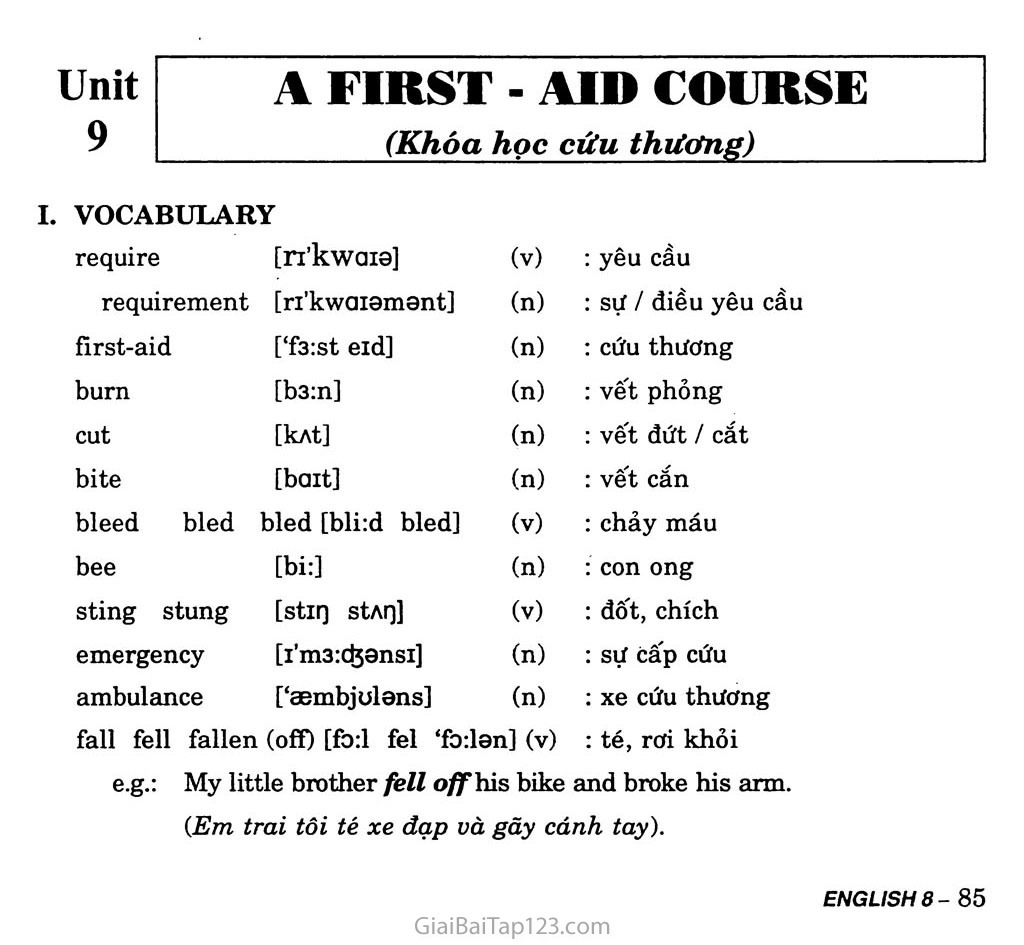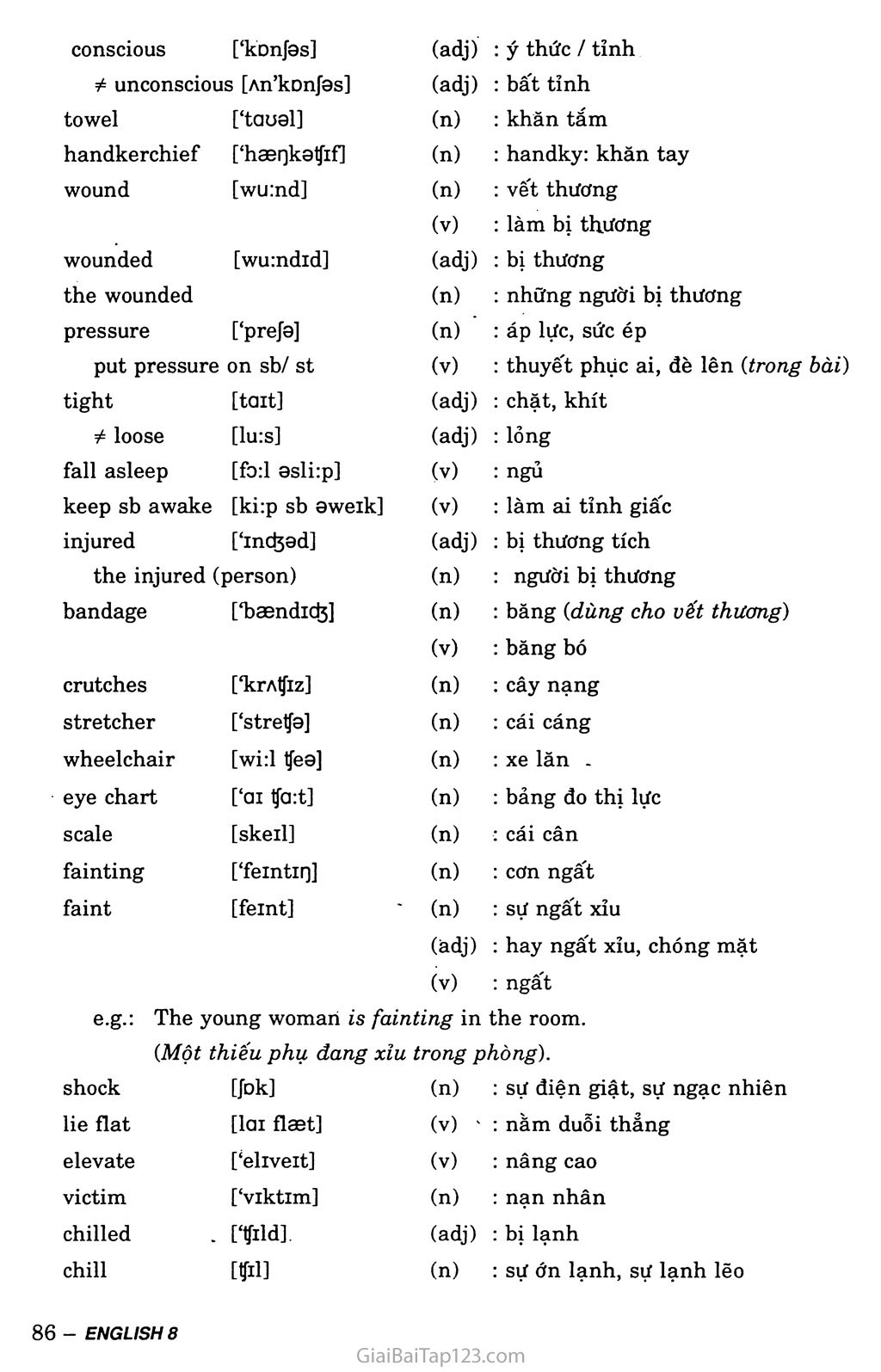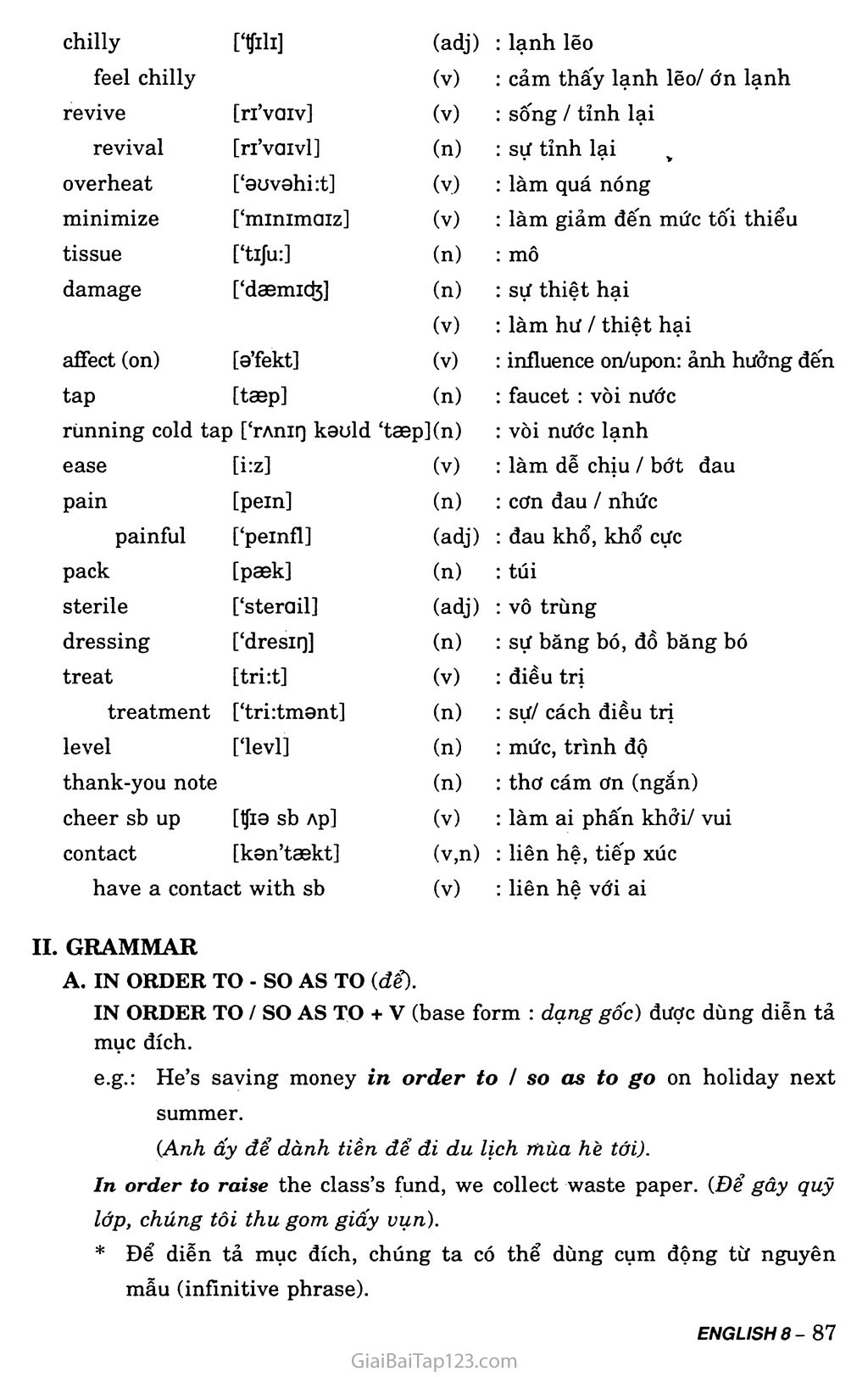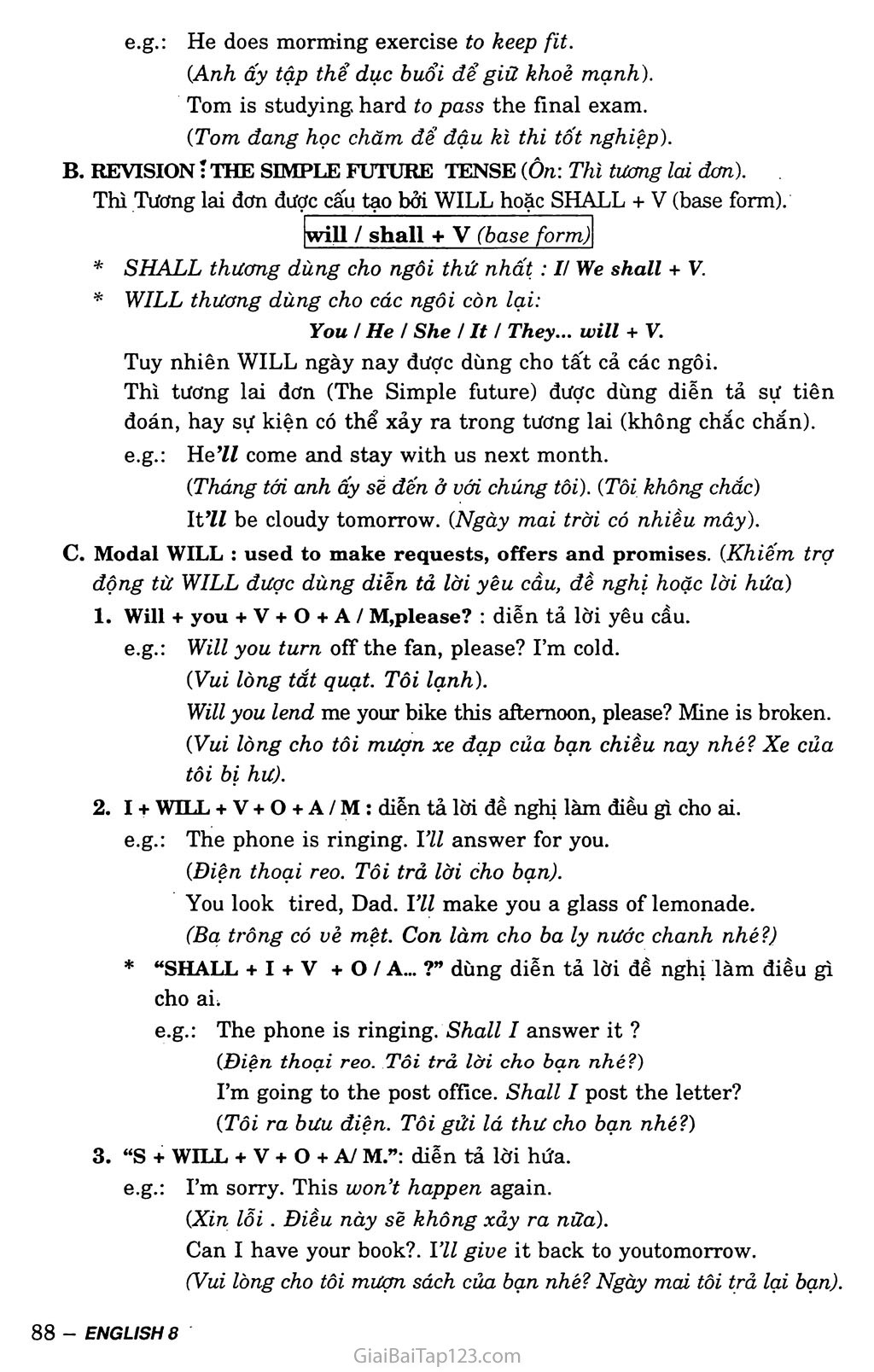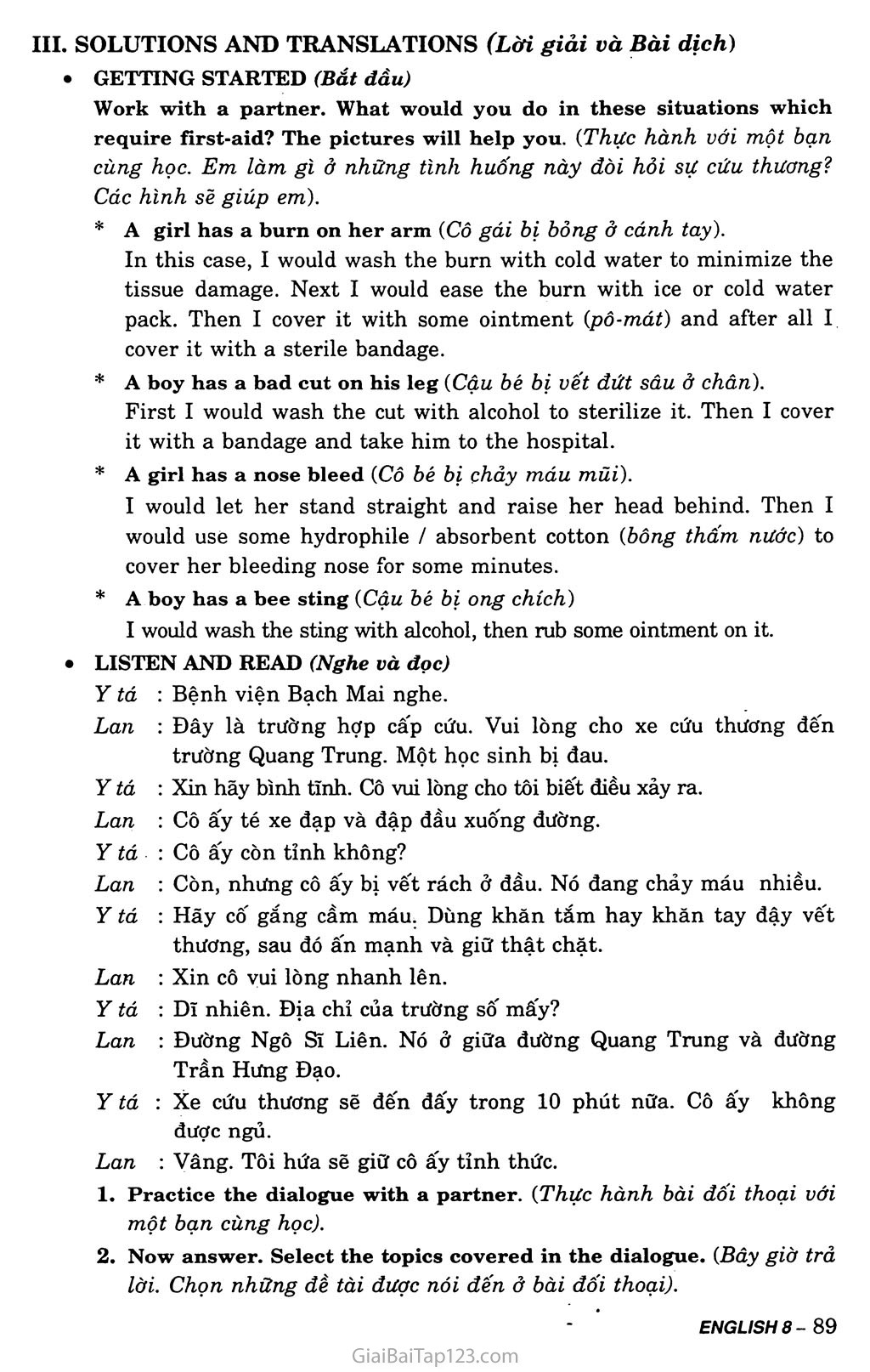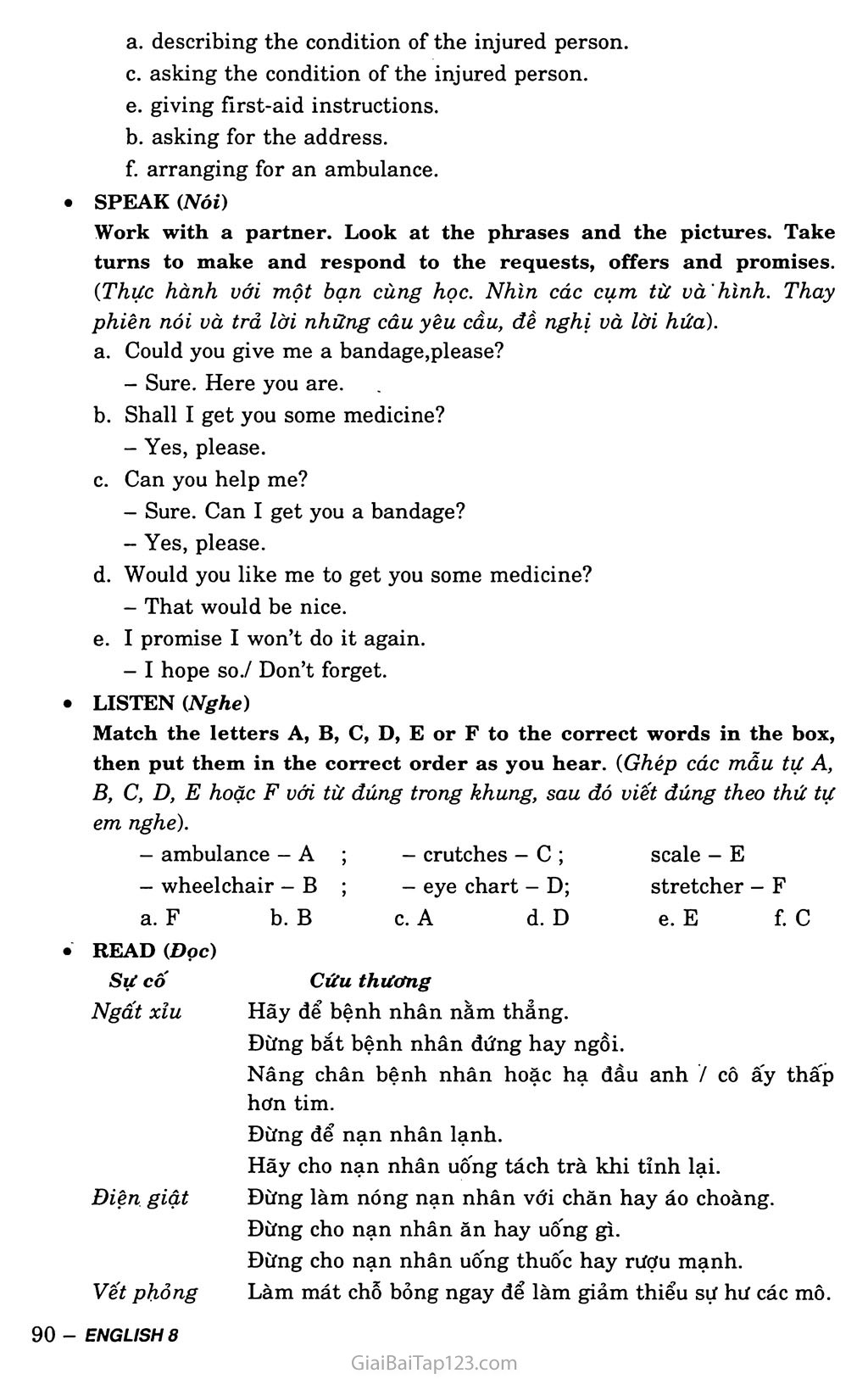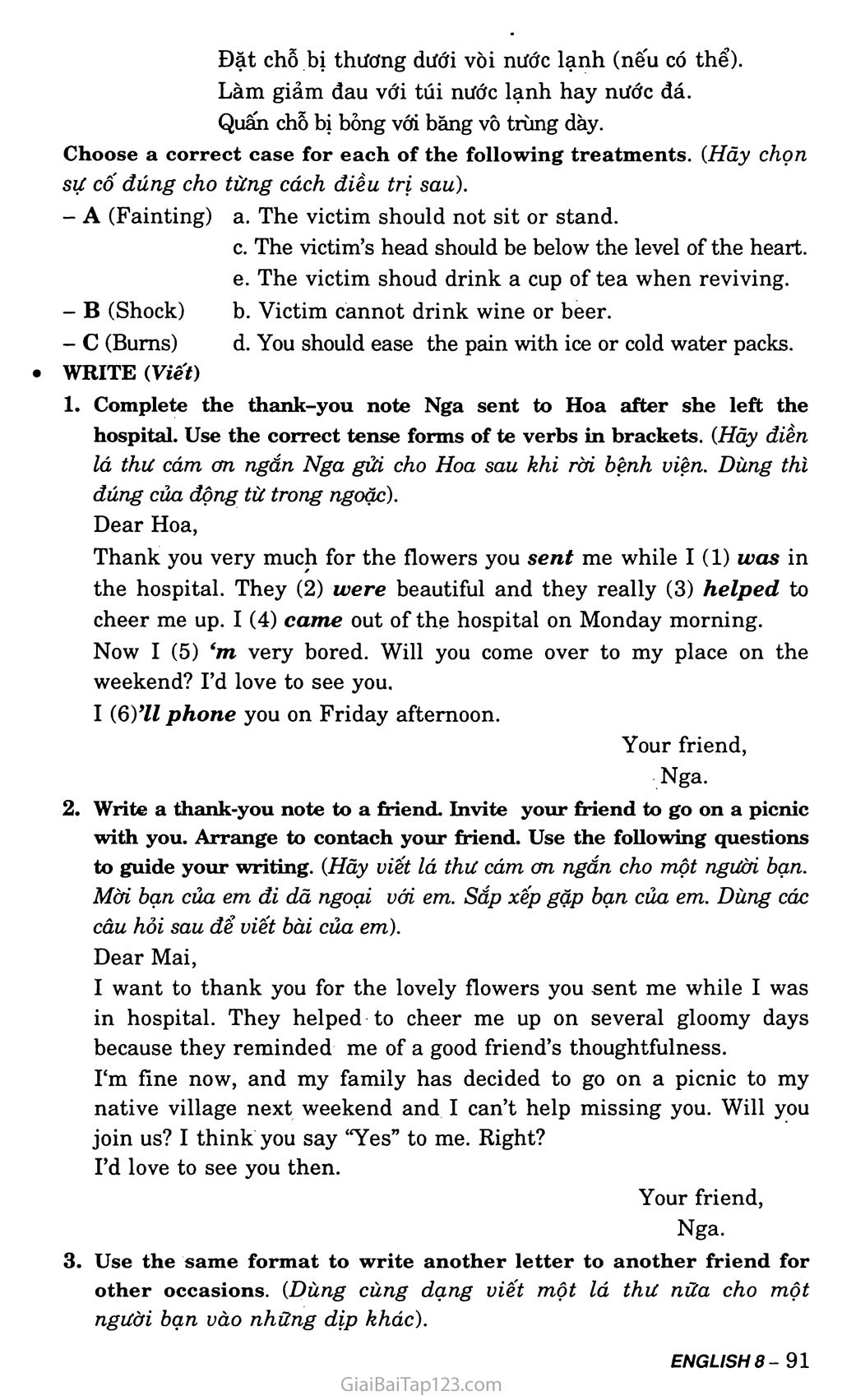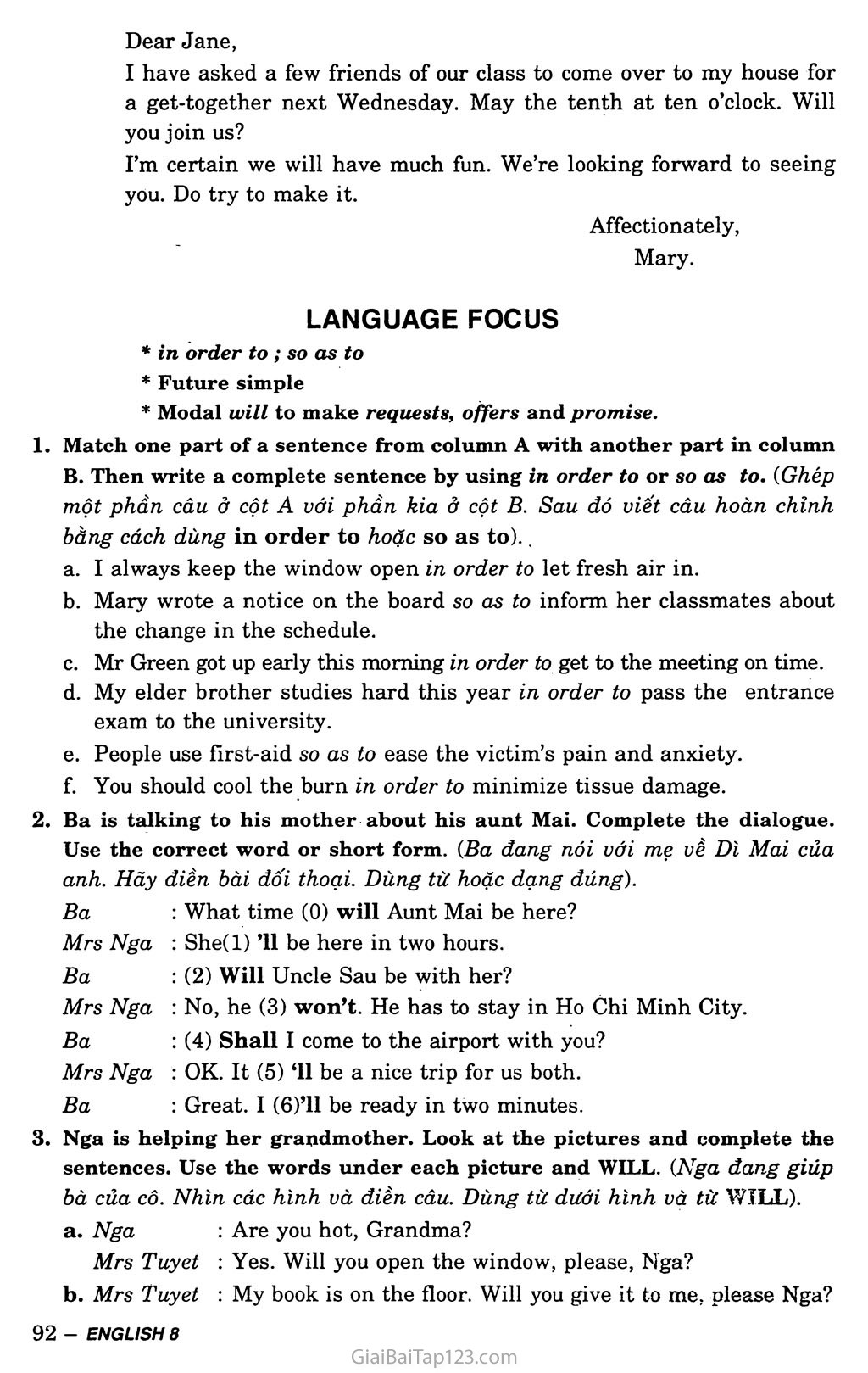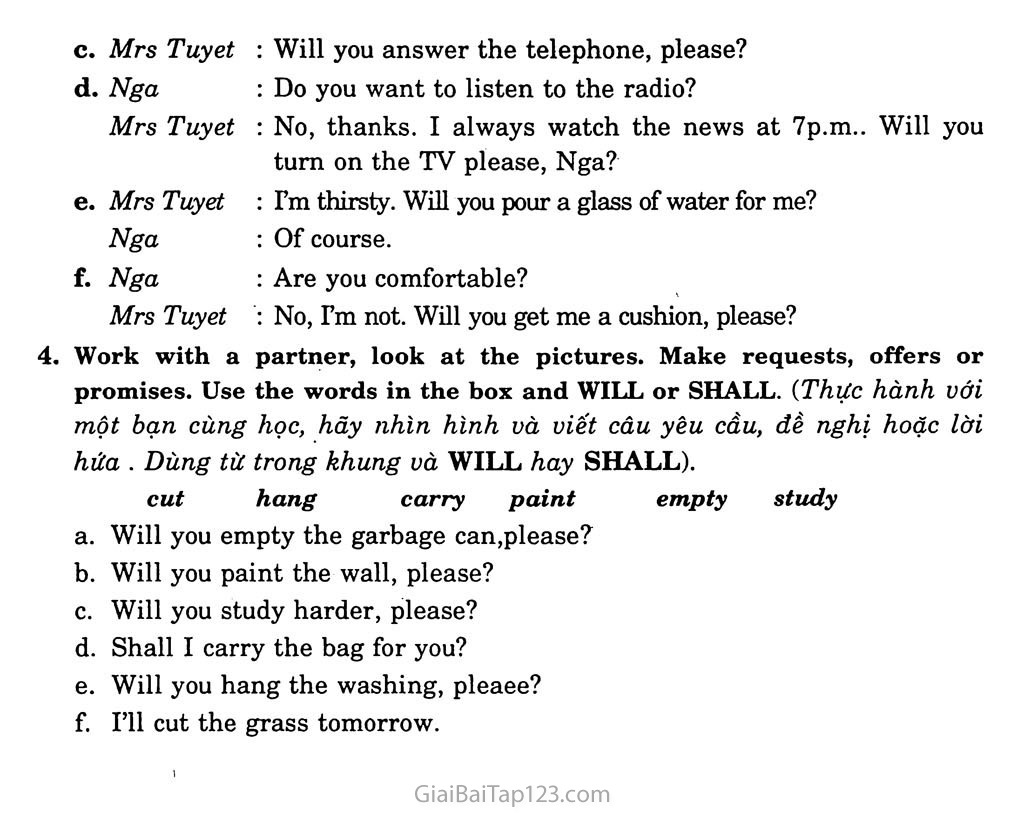Giải tiếng Anh lớp 8 Unit 9: A First - Aid Course
Unit
9
A FIRST - AID COURSE
(Khóa học cứu thương)
I. VOCABULARY
require
[ri’kwaia]
(v)
: yêu cầu
requirement
[ri’kwaiamant]
(n)
: sự / điều yêu cầu
first-aid
[‘f3:st eid]
(n)
:cứu thương
burn
[b3:n]
(n)
: vết phỏng
cut
[kAt]
(n)
: vết đứt / cắt
bite
[bait]
(n)
: vết cắn
bleed
bled
bled [bli:d bled]
(v)
: chảy máu
bee
[bi:]
(n)
: con ong
sting stung
[stir] stAq]
(v)
: đốt, chích
emergency
[i’m3:d5ansi]
(n)
: sự cấp cứu
ambulance
[‘aembjalens]
(n)
: xe cứu thương
fall fell
fallen (off) [foil fel *fo:lsn] (v)
: té, rơi khỏi
e.g.: My little brother fell off his bike and broke his arm. {Em trai tôi té xe đạp và gãy cánh tay).
conscious
[‘kDnfos]
(adj)
ý thức / tỉnh
unconscious [An’kDnJas]
(adj)
bất tỉnh
towel
[‘tausl]
(n)
khăn tắm
handkerchief
[‘hasQkatfif]
(n)
handky: khăn tay
wound
[wu:nd]
(n)
(v)
vết thương làm bị thương
wounded
[wu:ndid]
(adj)
bị thương
the wounded
(n)
những người bị thương
pressure
[‘prefo]
(n)
áp lực, sức ép
put pressure
on sb/ st
(v)
thuyết phục ai, đè lên {trong bài)
tight
[tait]
(adj)
chặt, khít
+ loose
[lu:s]
(adj)
lỏng
fall asleep
[fo:l 9sli:p]
(v)
ngủ
keep sb awake
[ki:p sb 9weik]
(v)
làm ai tỉnh giấc
injured
[*md59d]
(adj)
bị thương tích
the injured (person)
(n)
người bị thương
bandage
[‘baendiỢỉ]
(n)
(v)
băng {dùng cho vết thương) băng bó
crutches
[‘krAtfiz]
(n)
cây nạng
stretcher .
[‘stretfo]
(n)
cái cáng
wheelchair
[wi:l tfe9]
(n)
xe lăn .
eye chart
[‘ai tfa:t]
(n)
bảng đo thị lực
scale
[skeil]
(n)
cái cân
fainting
[‘feintirj]
(n)
cơn ngất
faint
[feint]
(n)
sự ngất xỉu
(àđj) : hay ngất xỉu, chóng mặt (v) : ngất
e.g.: The young woman is fainting in the room. {Một thiếu phụ đang xỉu trong phòng}.
shock
[Jbk]
(n)
: sự điện giật, sự ngạc nhiên
lie flat
[lai flset]
(v) ‘
: nằm duỗi thẳng
elevate
[‘eliveit]
(v)
: nâng cao
victim
[‘viktim]
(n)
: nạn nhân
chilled
. [‘fild].
(adj)
: bị lạnh
chill
[tfil]
(n)
: sự ớn lạnh, sự lạnh lẽo
chilly
[‘fill]
(adj)
lạnh lẽo
feel chilly
(v)
cảm thấy lạnh lẽo/ ớn lạnh
revive
[ri’vaiv]
(v)
sô'ng / tỉnh lại
revival
[ri’vaivl]
(n)
sự tỉnh lại v
overheat
[‘auvahi:t]
(y)
làm quá nóng
minimize
[‘minimaiz]
(v)
làm giảm đến mức tôi thiểu
tissue
[‘tlju:]
(n)
mô
damage
[‘daemidj]
(n)
(v)
sự thiệt hại làm hư / thiệt hại
affect (on)
[a’fekt]
(v)
influence on/upon: ảnh hưởng đến
tap
[taep]
(n)
faucet : vòi nước
running cold tap [‘rAniq kauld ‘taep](n)
vòi nước lạnh
ease
[i:z]
(v)
làm dễ chịu / bớt đau
pain
[pein]
(n)
cơn đau / nhức
painful
[‘peinfl]
(adj)
đau khổ, khổ cực
pack
[peek]
(n)
túi
sterile
[‘sterdil]
(adj)
vô trùng
dressing
[‘dresir)]
(n)
sự băng bó, đồ băng bó
treat
[tri:t]
(v)
điều trị
treatment
[‘tri:tmant]
(n)
sự/ cách điều trị
level
[‘levli
(n)
mức, trình độ
thank-you note
(n)
thơ cám ơn (ngắn)
cheer sb up
[tfia sb Ap]
(v)
làm ai phấn khởi/ vui
contact
[kan’taekt]
(v,n)
liên hệ, tiếp xúc
have a contact with sb
(v)
liên hệ với ai
GRAMMAR
A. IN ORDER TO - so AS TO (để).
IN ORDER TO / so AS TO + V (base form : dạng gốc) được dùng diễn tả mục đích.
e.g.: He’s saving money in order to I so as to go on holiday next summer.
(Anh ấy để dành tiễn để đi du lịch mùa hè tới).
In order to raise the class’s fund, we collect waste paper. (Để gây quỹ lớp, chúng tôi thu gom giấy vụn).
* Để diễn tả mục đích, chúng ta có thể dùng cụm động từ nguyên mẫu (infinitive phrase).
e.g.: He does morming exercise to keep fit.
{Anh ấy tập thể dục buổi để giữ khoẻ mạnh ).
Tom is studying, hard to pass the final exam.
{Tom đang học chăm để đậu kì thi tốt nghiệp).
B. REVISION: THE SIMPLE FUTURE TENSE (Ôn: Thì tương lai đơn).
Thì Tương lai đơn được cấu tạo bởi WILL hoặc SHALL + V (base form).
will / shall + V (base form)
SHALL thương dùng cho ngôi thứ nhất : u We shall + V.
WILL thương dùng cho các ngôi còn lại:
You / He / She / It I They... will + V.
Tuy nhiên WILL ngày nay được dùng cho tất cả các ngôi.
Thì tương lai đơn (The Simple future) được dùng diễn tả sự tiên đoán, hay sự kiện có thể xảy ra trong tương lai (không chắc chắn), e.g.: He’ll come and stay with US next month.
{Tháng tới anh ấy sẽ đến ở với chúng tôi). {Tôi không chắc)
It’ll be cloudy tomorrow. {Ngày mai trời có nhiều mây).
Modal WILL : used to make requests, offers and promises. {Khiếm trợ động từ WILL được dùng diễn tả lời yêu cầu, đề nghị hoặc lời hứa)
Will + you + V + o + A / M,please? : diễn tả lời yêu cầu. e.g.: Will you turn off the fan, please? I’m cold.
(Vui lòng tắt quạt. Tôi lạnh).
Will you lend me your bike this afternoon, please? Mine is broken. {Vui lòng cho tôi mượn xe đạp của bạn chiều nay nhé? Xe của tôi bị hư).
I + WILL + V+ O + A/ M: diễn tả lời đề nghị làm điều gì cho ai. e.g.: The phone is ringing. I’ll answer for you.
{Điện thoại reo. Tôi trả lời cho bạn).
You look tired, Dad. Vll make you a glass of lemonade.
(Ba trông có vẻ mệt. Con làm cho ba ly nước chanh nhé?)
* “SHALL + I + V + o / A... ?” dùng diễn tả lời đề nghị làm điều gì cho ai.
e.g.: The phone is ringing. Shall I answer it ?
{Điện thoại reo. Tôi trả lời cho bạn nhé?)
I’m going to the post office. Shall I post the letter?
{Tôi ra bưu điện. Tôi gửi lá thư cho bạn nhé?)
“S + WILL + V + o + A/M”: diễn tả lời hứa. e.g.: I’m sorry. This won’t happen again.
{Xin lỗi. Điều này sẽ không xảy ra nữa).
Can I have your book?, vu give it back to youtomorrow.
(Vui lòng cho tôi mượn sách của bạn nhé? Ngày mai tôi trả lại bạn).
SOLUTIONS AND TRANSLATIONS (Lời giải và Bài dịch)
GETTING STARTED (Bắt đầu)
Work with a partner. What would you do in these situations which require first-aid? The pictures will help you. (Thực hành với một bạn cùng học. Em làm gì ở những tình huống này đòi hỏi sự cứu thương? Các hình sẽ giúp em).
A girl has a burn on her arm (Cô gái bị bỏng ở cánh tay).
In this case, I would wash the burn with cold water to minimize the tissue damage. Next I would ease the burn with ice or cold water pack. Then I cover it with some ointment (pô-mát) and after all I cover it with a sterile bandage.
A boy has a bad cut on his leg (Cậu bé bị vết đứt sâu ở chân).
First I would wash the cut with alcohol to sterilize it. Then I cover it with a bandage and take him to the hospital.
A girl has a nose bleed (Cô bé bị chảy máu mủi).
I would let her stand straight and raise her head behind. Then I would use some hydrophile / absorbent cotton (bông thấm nước) to cover her bleeding nose for some minutes.
A boy has a bee sting (Cậu bé bị ong chích)
I would wash the sting with alcohol, then rub some ointment on it.
LISTEN AND READ (Nghe và đọc)
tá : Bệnh viện Bạch Mai nghe.
Lan : Đây là trường hợp cấp cứu. Vui lòng cho xe cứu thương đến trường Quang Trung. Một học sinh bị đau.
tá : Xin hãy bình tĩnh. Cô vui lòng cho tôi biết điều xảy ra.
Lan : Cô ấy té xe đạp và đập đầu xuống đường.
tá : Cô ấy còn tỉnh không?
Lan : Còn, nhưng cô ấy bị vết rách ở đầu. Nó đang chảy máu nhiều.
tá : Hãy cô' gắng cầm máu. Dùng khăn tắm hay khăn tay đậy vết
thương, sau đó ấn mạnh và giữ thật chặt.
Lan : Xin cô vui lòng nhanh lên.
tá : Dĩ nhiên. Địa chỉ của trường sô' mấy?
Lan : Đường Ngô Sĩ Liên. Nó ở giữa đường Quang Trung và đường Trần Hưng Đạo.
tá : Xe cứu thương sẽ đến đấy trong 10 phút nữa. Cô ấy không
được ngủ.
Lan : Vâng. Tôi hứa sẽ giữ cô ấy tỉnh thức.
Practice the dialogue with a partner. (Thực hành bài đôi thoại với một bạn cùng học).
Now answer. Select the topics covered in the dialogue. (Bây giờ trả lời. Chọn những đề tài được nói đến ở bài đối thoại).
describing the condition of the injured person,
asking the condition of the injured person.
giving first-aid instructions.
asking for the address.
arranging for an ambulance.
SPEAK (Nói)
Work with a partner. Look at the phrases and the pictures. Take turns to make and respond to the requests, offers and promises.
(Thực hành với một bạn cùng học. Nhìn các cụm từ và 'hình. Thay phiên nói và trả lời những câu yêu cầu, đề nghị và lời hứa).
Could you give me a bandage,please?
Sure. Here you are.
Shall I get you some medicine?
Yes, please.
Can you help me?
Sure. Can I get you a bandage?
Yes, please.
Would you like me to get you some medicine?
That would be nice.
I promise I won’t do it again.
I hope so./ Don’t forget.
LISTEN (Ng he)
Match the letters A, B, c, D, E or F to the correct words in the box, then put them in the correct order as you hear. (Ghép các mẫu tự A, B, c, D, E hoặc F với từ đúng trong khung, sau đó viết đúng theo thứ tự em nghe).
crutches — c ;
eye chart - D;
scale - E stretcher — F
e. E f. c
ambulance — A
a. F
READ (Dọc) Sự cố
Ngất xỉu
Điện giật
Vết phỏng
b. B c. A d. D
wheelchair - B
Cứu thương
Hãy để bệnh nhân nằm thẳng.
Đừng bắt bệnh nhân đứng hay ngồi.
Nâng chân bệnh nhân hoặc hạ đầu anh 7 cô ấy thấp hơn tim.
Đừng để nạn nhân lạnh.
Hãy cho nạn nhân uô'ng tách trà khi tỉnh lại.
Đừng làm nóng nạn nhân với chăn hay áo choàng.
Đừng cho nạn nhân ăn hay uống gì.
Đừng cho nạn nhân uống thuổc hay rượu mạnh.
Làm mát chỗ bỏng ngay để làm giảm thiểu sự hư các mô.
Đặt chỗ bị thương dưới vòi nước lạnh (nếu có thể).
Làm giảm đau với túi nước lạnh hay nước đá.
Quấn chỗ bị bỏng với băng vô trùng dày.
Choose a correct case for each of the following treatments. {Hãy chọn Sự cố đúng cho từng cách điều trị sau).
- A (Fainting) a. The victim should not sit or stand.
B (Shock)
c (Bums) WRITE (Viết)
The victim’s head should be below the level of the heart, e. The victim shoud drink a cup of tea when reviving,
Victim cannot drink wine or beer.
You should ease the pain with ice or cold water packs.
Complete the thank-you note Nga sent to Hoa after she left the hospital. Use the correct tense forms of te verbs in brackets. (Hãy điền lá thư cám ơn ngắn Nga gửi cho Hoa sau khi rời bệnh viện. Dùng thì đúng của động từ trong ngoặc).
Dear Hoa,
Thank you very much for the flowers you sent me while I (1) was in the hospital. They (2) were beautiful and they really (3) helped to cheer me up. I (4) came out of the hospital on Monday morning.
Now I (5) ‘m very bored. Will you come over to my place on the weekend? I’d love to see you.
I (6)7Z phone you on Friday afternoon.
Your friend,
Nga.
Write a thank-you note to a friend. Invite your friend to go on a picnic with you. Arrange to contach your friend. Use the following questions to guide your writing. (Hãy viết lá thư cám ơn ngắn cho một người bạn. Mời bạn của em đi dã ngoại với em. Sắp xếp gặp bạn của em. Dùng các câu hỏi sau để viết bài của em).
Dear Mai,
I want to thank you for the lovely flowers you sent me while I was in hospital. They helped to cheer me up on several gloomy days because they reminded me of a good friend’s thoughtfulness.
I‘m fine now, and my family has decided to go on a picnic to my native village next weekend and I can’t help missing you. Will you join us? I think you say “Yes” to me. Right?
I’d love to see you then.
Your friend,
Nga.
Use the same format to write another letter to another friend for other occasions. (Dùng cùng dạng viết một lá thư nữa cho một người bạn vào những dịp khác).
Dear Jane,
I have asked a few friends of our class to come over to my house for a get-together next Wednesday. May the tenth at ten o’clock. Will you join us?
I’m certain we will have much fun. We’re looking forward to seeing you. Do try to make it.
Affectionately,
Mary.
LANGUAGE FOCUS
in order to ; so as to
Future simple
Modal will to make requests, offers and promise.
Match one part of a sentence from column A with another part in column B. Then write a complete sentence by using in order to or so as to. {Ghép một phần câu ở cột A với phần kia ở cột B. Sau đó viết câu hoàn chỉnh bằng cách dùng in order to hoặc so as to).
I always keep the window open in order to let fresh air in.
Mary wrote a notice on the board so as to inform her classmates about the change in the schedule.
Mr Green got up early this morning in order to get to the meeting on time.
My elder brother studies hard this year in order to pass the entrance exam to the university.
People use first-aid so as to ease the victim’s pain and anxiety.
You should cool the burn in order to minimize tissue damage.
Ba is talking to his mother about his aunt Mai. Complete the dialogue. Use the correct word or short form. {Ba đang nói với mẹ về Dì Mai của anh. Hãy điền bài đối thoại. Dùng từ hoặc dạng đúng).
Ba : What time (0) will Aunt Mai be here?
Mrs Nga : She(l) ’ll be here in two hours.
Ba : (2) Will Uncle Sau be with her?
Mrs Nga : No, he (3) won’t. He has to stay in Ho Chi Minh City.
Ba : (4) Shall I come to the airport with you?
Mrs Nga : OK. It (5) ‘11 be a nice trip for us both.
Ba : Great. I (6)’ll be ready in two minutes.
Nga is helping her grandmother. Look at the pictures and complete the sentences. Use the words under each picture and WILL. {Nga đang giúp bà của cô. Nhìn các hình và điền câu. Dùng từ dưới hình và từ Y/ĨLL).
Nga : Are you hot, Grandma?
Mrs Tuyet : Yes. Will you open the window, please, Nga?
Mrs Tuyet : My book is on the floor. Will you give it to me, please Nga?
Mrs Tuyet : Will you answer the telephone, please?
Nga : Do you want to listen to the radio?
Mrs Tuyet : No, thanks. I always watch the news at 7p.m.. Will you turn on the TV please, Nga?
Mrs Tuyet : I’m thirsty. Will you pour a glass of water for me?
Nga : Of course.
Nga : Are you comfortable?
Mrs Tuyet : No, I’m not. Will you get me a cushion, please?
Work with a partner, look at the pictures. Make requests, offers or
promises. Use the words in the box and WILL or SHALL. (Thực hành với một bạn cùng học, hãy nhìn hình và viết câu yêu cầu, đề nghị hoặc lời hứa . Dùng từ trong khung và WILL hay SHALL).
cut hang carry paint empty study
Will you empty the garbage can,please?
Will you paint the wall, please?
Will you study harder, please?
Shall I carry the bag for you?
Will you hang the washing, pleaee?
I’ll cut the grass tomorrow.

